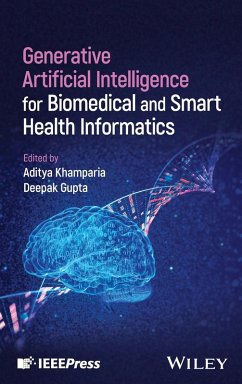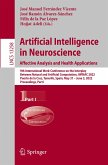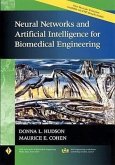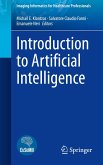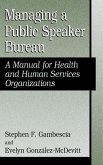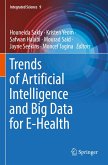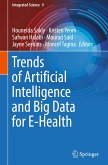Khamparia
Generative Artificial Intelligence for Biomedical and Smart Health Informatics
Herausgeber: Khamparia, Aditya; Gupta, Deepak
Khamparia
Generative Artificial Intelligence for Biomedical and Smart Health Informatics
Herausgeber: Khamparia, Aditya; Gupta, Deepak
- Gebundenes Buch
- Merkliste
- Auf die Merkliste
- Bewerten Bewerten
- Teilen
- Produkt teilen
- Produkterinnerung
- Produkterinnerung
Enables readers to understand the future of medical applications with generative AI and related applications Generative Artificial Intelligence for Biomedical and Smart Health Informatics delivers a comprehensive overview of the most recent generative AI-driven medical applications based on deep learning and machine learning in which biomedical data is gathered, processed, and analyzed using data augmentation techniques. This book covers many applications of generative models for medical image data, including volumetric medical image segmentation, data augmentation, MRI reconstruction, and…mehr
Andere Kunden interessierten sich auch für
![Artificial Intelligence in Neuroscience: Affective Analysis and Health Applications Artificial Intelligence in Neuroscience: Affective Analysis and Health Applications]() Artificial Intelligence in Neuroscience: Affective Analysis and Health Applications66,99 €
Artificial Intelligence in Neuroscience: Affective Analysis and Health Applications66,99 €![Neural Networks and Artificial Intelligence for Biomedical Engineering Neural Networks and Artificial Intelligence for Biomedical Engineering]() Donna L HudsonNeural Networks and Artificial Intelligence for Biomedical Engineering209,99 €
Donna L HudsonNeural Networks and Artificial Intelligence for Biomedical Engineering209,99 €![Introduction to Artificial Intelligence Introduction to Artificial Intelligence]() Introduction to Artificial Intelligence56,99 €
Introduction to Artificial Intelligence56,99 €![Managing a Public Speaker Bureau Managing a Public Speaker Bureau]() Stephen F. GambesciaManaging a Public Speaker Bureau52,99 €
Stephen F. GambesciaManaging a Public Speaker Bureau52,99 €![Trends of Artificial Intelligence and Big Data for E-Health Trends of Artificial Intelligence and Big Data for E-Health]() Trends of Artificial Intelligence and Big Data for E-Health76,99 €
Trends of Artificial Intelligence and Big Data for E-Health76,99 €![Trends of Artificial Intelligence and Big Data for E-Health Trends of Artificial Intelligence and Big Data for E-Health]() Trends of Artificial Intelligence and Big Data for E-Health106,99 €
Trends of Artificial Intelligence and Big Data for E-Health106,99 €![Artificial Intelligence in Radiation Therapy Artificial Intelligence in Radiation Therapy]() Artificial Intelligence in Radiation Therapy177,99 €
Artificial Intelligence in Radiation Therapy177,99 €-
-
-
Enables readers to understand the future of medical applications with generative AI and related applications Generative Artificial Intelligence for Biomedical and Smart Health Informatics delivers a comprehensive overview of the most recent generative AI-driven medical applications based on deep learning and machine learning in which biomedical data is gathered, processed, and analyzed using data augmentation techniques. This book covers many applications of generative models for medical image data, including volumetric medical image segmentation, data augmentation, MRI reconstruction, and modeling of spatiotemporal medical data. The book explores findings obtained by explainable AI techniques, with coverage of various techniques rarely reported in literature. Throughout, feedback and user experiences from physicians and medical staff, as well as use cases, are included to provide important context. The book discusses topics including privacy and security challenges in AI-enabled health informatics, biosensor-guided AI interventions in personalized medicine, regulatory frameworks and guidelines for AI-based medical devices, education and training for building responsible AI solutions in healthcare, and challenges and opportunities in integrating generative AI with wearable devices. Topics covered include: * Treatment of neurological disorders using intelligent techniques and image-guided and tomography interventions for neuromuscular disorders * Bio-inspired smart healthcare service frameworks with AI, machine learning, and deep learning, integration of IoT devices, and edge computing in industrial and clinical systems * Traffic management and optimization in distributed environments, patient data management, disease surveillance and prediction, and telemedicine and remote monitoring * Education-driven, peer-to-peer, and service-oriented architectures and transparency and accountability in medical decision-making Generative Artificial Intelligence for Biomedical and Smart Health Informatics is an essential reference for computer science researchers, medical professionals, healthcare informatics, and medical imaging researchers interested in understanding the potential of artificial intelligence and other related technologies in healthcare.
Produktdetails
- Produktdetails
- Verlag: Wiley
- Seitenzahl: 704
- Erscheinungstermin: 19. Februar 2025
- Englisch
- Abmessung: 229mm x 152mm x 38mm
- Gewicht: 1093g
- ISBN-13: 9781394280704
- ISBN-10: 139428070X
- Artikelnr.: 71707789
- Herstellerkennzeichnung
- Libri GmbH
- Europaallee 1
- 36244 Bad Hersfeld
- gpsr@libri.de
- Verlag: Wiley
- Seitenzahl: 704
- Erscheinungstermin: 19. Februar 2025
- Englisch
- Abmessung: 229mm x 152mm x 38mm
- Gewicht: 1093g
- ISBN-13: 9781394280704
- ISBN-10: 139428070X
- Artikelnr.: 71707789
- Herstellerkennzeichnung
- Libri GmbH
- Europaallee 1
- 36244 Bad Hersfeld
- gpsr@libri.de
Aditya Khamparia, Assistant Professor, Department of Computer Science at Babasaheb Bhimrao Ambedkar University, India. His research areas include Artificial Intelligence, Intelligent Data Analysis, Machine Learning, Deep Learning, and Soft Computing. Deepak Gupta, Assistant Professor, Department of Computer Science and Engineering, Maharaja Agrasen Institute of Technology, Delhi, India. His research interests include intelligent data analysis, nature-inspired computing, machine learning, and soft computing.
About the Editors xxvii
List of Contributors xxix
Preface xxxix
Acknowledgments xli
1 Generative AI in Wearables: Exploring the Impact of GANs, VAEs, and
Transformers 1
Diwakar Diwakar and Deepa Raj
1.1 Introduction 1
1.2 Theoretical Foundations 7
1.3 Opportunities of Integration 14
1.4 Research and Development Insights 16
1.5 Ethical and Regulatory Considerations 24
1.6 Case Studies and Applications 26
1.7 Future Directions and Emerging Trends 27
1.8 Conclusion 31
References 32
2 Safeguarding Privacy and Security in AI-Enabled Healthcare Informatics 35
Akanksha Kochhar, Ganeev Kaur Chhabra, Toshika Goswami, and Moolchand
Sharma
2.1 Introduction 35
2.2 Drawbacks and Their Possible Solutions 38
2.3 Applications 43
2.4 Devices 44
2.5 Future Scope 46
2.6 Conclusion 47
2.7 Future Scope 48
References 49
3 Generating Synthetic Medical Data Using GAI 51
Sudhanshu Singh, Suruchi Singh, and C.S. Raghuvanshi
3.1 Introduction 51
3.2 Uncloaking the GAI Orchestra: A Compendium of Techniques 53
3.3 Beyond the Notes: Ethical Considerations and Responsible Use 66
3.4 Conclusion 70
References 70
4 Automation of Drug Design and Development 73
Sudhanshu Singh
4.1 Introduction 73
4.2 High-Throughput Screening (HTS) 74
4.3 Artificial Intelligence (AI) and Machine Learning (ML) 77
4.4 Automation in Drug Synthesis and Optimization 80
4.5 Automation in Clinical Trials 81
4.6 Challenges and Opportunities 83
4.7 Conclusion 85
References 87
5 Autism Spectrum Disorder Diagnosis: A Comprehensive Review of Machine
Learning Approaches 89
Deepti Prasad and Suman Bhatia
5.1 Introduction 89
5.2 Machine Learning and Deep Learning Algorithms 92
5.3 Discussion 98
5.4 Future Work 99
5.5 Conclusion 99
References 100
6 Temporal Normalization and Brain Image Analysis for Early-Stage
Prediction of Attention Deficit Hyperactivity Disorder (ADHD) 103
Poonam Chaudhary, Nikki Rani, Diksha Aggarwal, and Srishti Sharma
6.1 Introduction 103
6.2 Exploratory Data Analysis 105
6.3 Methodology 109
6.4 Results and Discussion 115
6.5 Conclusion 116
References 117
7 Sustainable Agriculture Through Advanced Crop Management: VGG16-Based Tea
Leaf Disease Recognition 121
R. Sivaraman, S. Praveena, and H. Naresh Kumar
7.1 Introduction 121
7.2 Literature Survey 122
7.3 Proposed Methodology for Tea Leaf Diseases Detection 125
7.4 Results and Discussion 130
7.5 Conclusion 131
References 132
8 Advancing Colorectal Cancer Diagnosis: Integrating Synthetic Data and
Machine Learning for Microbiome Analysis 135
Alessio Rotelli and Ernesto Iadanza
8.1 Colorectal Cancer (CRC) 135
8.2 Understanding the Gut Microbiome 136
8.3 Influence of the Gut Microbiome Dysbiosis on Colorectal Adenomas and
CRC 136
8.4 Differentiating Adenomatous Polyps (AP) from CRC 137
8.5 Use of Data Augmentation 138
8.6 Data Evaluation Metrics 138
8.7 Feature Extraction by Later-Wise Relevance Propagation 139
8.8 Beta Diversity Analysis 140
8.9 Machine Learning and SHAP Analysis to Classify AP and CRC Samples 141
8.10 Results of Classification and SHAP Analysis 143
8.11 Key Bacterial Taxa Discriminating Between AP and CRC: Insights from
Feature Extraction and SHAP Analysis 149
8.12 Conclusion 149
References 150
9 Recent Knowledge in Drug Design and Development: Automation and
Advancement 153
Kusum Gurung, Saurav K. Mishra, Tabsum Chhetri, Sneha Roy, Anagha
Balakrishnan, and John J. Georrge
9.1 Introduction 153
9.2 Automation in Drug Design and Development 156
9.3 Tools and Database for Drug Design, including Algorithm and Application
158
9.4 Automation in Drug Design and Its Impact on the Pharmaceutical Sector
160
9.5 Automation-Assisted Successful Studies in Drug Design 165
9.6 Advancement and Challenges 170
9.7 Conclusion 171
References 172
10 Machine Learning and Generative AI Techniques for Sentiment Analysis
with Applications 183
Riya Sharma, Balraj Singh, and Aditya Khamparia
10.1 Introduction 183
10.2 Literature Review 187
10.3 Machine Learning Techniques for Sentiment Analysis 187
10.4 Generative AI Techniques for Sentiment Analysis 196
10.5 Conclusion 202
References 203
11 Use of AI with Optimization Techniques: Case Study, Challenges, and
Future Trends 209
Ayushi Mittal, Parul Parul, Charu Gupta, and Devendra K. Tayal
11.1 Introduction 209
11.2 Overview of Medical Disease Prediction Models 213
11.3 Importance of Optimization in Enhancing Prediction Accuracy 214
11.4 Commonly Used Optimization Algorithms in Medical Predictive Modeling
214
11.5 Integration of ML and Optimization for Disease Prediction 222
11.6 Challenges and Considerations in Applying Optimization Techniques to
Medical Data 223
11.7 Case Studies: Successful Applications of Optimization in Disease
Prediction 226
11.8 Future Directions and Emerging Trends in Optimizing Medical Prediction
Models 228
11.9 Ethical and Regulatory Implications of Optimized Disease Prediction
Systems 231
11.10 Conclusion: Harnessing Optimization for Advancements in Medical
Predictive Analytics 233
11.11 Future Scope 234
References 234
12 Inclusive Role of Internet of (Healthcare) Things in Digital Health:
Challenges, Methods, and Future Directions 239
Mohammed Abdalla
12.1 Introduction 239
12.2 The Internet of Medical Things' (IoMT) Revolution in Healthcare 242
12.3 The Integration Between Internet of (Healthcare) Things and Digital
Health 243
12.4 Blockchain Applications in the Healthcare Systems 248
12.5 Healthcare IoT Future Directions: For Digital Health 249
12.6 Conclusion 252
References 253
13 Generating Synthetic Medical Dataset Using Generative AI: ACaseStudy 259
Partha Pratim Ray
13.1 Introduction 259
13.2 Methodology 260
13.3 Results 265
13.4 Conclusion 270
References 270
14 A Comprehensive Review of Cardiac Image Analysis for Precise Heart
Disease Diagnosis Using Deep Learning Techniques 275
Anuj Gupta, Vikas Kumar, and Aryan Nakhale
14.1 Introduction 275
14.2 Literature Review 276
14.3 Machine Learning Methods 278
14.4 Proposed System 279
14.5 Mathematical Model 282
14.6 Data Preparation 284
14.7 Results and Discussion 286
14.8 Conclusion and Future Work 292
References 293
15 Classification Methods of Deep Learning for Detecting Autism Spectrum
Disorder in Children (4-12 Years) 297
Yashashwini Reddy, Chinthala Kishor Kumar Reddy, Kari Lippert, and Sahithi
Reddy
15.1 Introduction 297
15.2 Relevant Work 302
15.3 Proposed Methodology 305
15.4 Results 312
15.5 Conclusion 314
References 317
16 Deep Learning Model for Resolution Enhancement of Biomedical Images for
Biometrics 321
Bhallamudi RaviKrishna, Madireddy Vijay Reddy, Mukesh Soni, Haewon Byeon,
Sagar D. Pande, and Maher A. Rusho
16.1 Introduction 321
16.2 Model 324
16.3 Experiments and Results 332
16.4 Conclusion 338
References 338
17 Tackling the Complexities of Federated Learning 343
Raj Thakur, Shreyansh Patel, Neelesh Singh, Aaryan Barde, and Snehlata
Barde
17.1 Introduction 343
17.2 Why We Come to Federated Learning 344
17.3 Related Work 344
17.4 Challenges in Federated Learning 345
17.5 Techniques Used in Federated Learning 347
17.6 Applications 350
17.7 Result and Analysis 351
17.8 Conclusion 351
References 352
18 Revolutionizing Healthcare: The Impact of AI-Powered Sensors 355
Veenadhari Bhamidipaty, Durgananda Lahari Bhamidipaty, Indira Guntoory,
Kanaka Durga Prasad Bhamidipaty, Karthikeyan P. Iyengar, Bhuvan Botchu, and
Rajesh Botchu
18.1 Introduction 355
18.2 Evolution of Healthcare Technology 356
18.3 Understanding AI-Powered Sensors 358
18.4 Enhancing Patient Monitoring and Diagnosis 359
18.5 Improving Treatment Outcomes 361
18.6 Remote Healthcare and Telemedicine 362
18.7 Challenges and Ethical Considerations 363
18.8 Regulatory Landscape 365
18.9 Future Directions and Opportunities 366
18.10 Case Studies and Success Stories 367
References 370
19 GAI and Deep Learning-Based Medical Sensor Data Relationship Model for
Health Informatics 375
Kirti Shukla, Pramod Kumar, Mukesh Soni, Haewon Byeon, Sagar Dhanraj Pande,
and Ismail Keshta
19.1 Introduction 375
19.2 Related Work 379
19.3 DSRF Based on Dynamic and Static Relationships Fusion of Multisource
Health Sensing Data 381
19.4 Experiments and Analysis 388
19.5 Conclusion 397
References 397
20 Leveraging Generative Adversarial Networks for Image Augmentation in
Deep Learning 401
Ravi Kumar, Akshay Kanwar, Amritpal Singh, and Aditya Khamparia
20.1 Introduction 401
20.2 Literature Review 403
20.3 Material and Method 411
20.4 Result and Discussion 413
20.5 Conclusion 414
References 414
21 Exploring Trust and Mistrust Dynamics: Generative Ai-curated Narratives
in Health Communication Media Content Among Gen X 417
Seema Shukla, Babita Pandey, Devendra Kumar Pandey, Brijendra Pratap
Mishra, and Aditya Khamparia
21.1 Background 417
21.2 Related Work 418
21.3 Theoretical Framework 420
21.4 Research Methodology 420
21.5 Data Analysis 423
21.6 Results 424
21.7 Conclusions and Discussion 428
References 430
22 Generative Intelligence-Based Federated Learning Model for Brain Tumor
Classification in Smart Health 435
Niladri Maiti, Riddhi Chawla, Aadam Quraishi, Mukesh Soni, Maher Ali Rusho,
and Sagar Dhanraj Pande
22.1 Introduction 435
22.2 Classification Model 438
22.3 Experiment 444
22.4 Conclusion 449
References 450
23 AI-Based Emotion Detection System in Healthcare for Patient 455
Ati Jain and Amiyavardhan Jain
23.1 Introduction 455
23.2 Literature Survey 456
23.3 AI in Healthcare Sector 458
23.4 Methodology 465
23.5 Conclusion 465
References 467
24 Leveraging Process Mining for Enhanced Efficiency and Precision in
Healthcare 471
Parth Sharma, Sohan Kumar, Tanay Falor, Om Dabral, Abhinav Upadhyay, Rishik
Gupta, and Vanshika Singh Andotra
24.1 Introduction 471
24.2 Process Mining 472
24.3 Main Focus of the Chapter 474
24.4 Problems 476
24.5 Solution 476
24.6 Tools 477
24.7 Ways Process Mining Solves Healthcare 479
24.8 One Solution: Robotic Process Automation (RPA) 482
24.9 Case Study: Process Mining for Optimized COVID-19 ICU Care 483
24.10 Conclusion 486
References 487
25 Transform Drug Discovery and Development With Generative Artificial
Intelligence 489
Antonio Lavecchia
25.1 Introduction 489
25.2 Dataset, Molecular Representation, and Benchmark Platforms in
Molecular Generation 491
25.3 Deep Generative Model Architectures 499
25.4 AI Applications in Drug Discovery and Development 511
25.5 Challenges and Future Outlooks 516
Acknowledgments 519
References 520
26 Medical Image Analysis and Morphology with Generative Artificial
Intelligence for Biomedical and Smart Health Informatics 539
Dharmendra Dangi, Arish Mallick, Amit Bhagat, and Dheeraj Kumar Dixit
26.1 Introduction 539
26.2 Medical Imaging 541
26.3 Various Types of Modalities 543
26.4 Medical Imaging Analysis 549
26.5 Conventional Morphological Image Processing 551
26.6 Rotational Morphological Processing 553
References 560
27 Machine Learning Applications in the Prediction of Polycystic Ovarian
Syndrome 565
Ardra Nair, Virrat Devaser, and Komal Arora
27.1 Introduction 565
27.2 Literature Review 569
27.3 ml Techniques for Polycystic Ovarian Syndrome 569
27.4 Artificial Neural Network and Deep Learning 580
27.5 Challenges 584
27.6 Conclusion 585
References 585
28 Diagnosis and Classification of Skin Cancer Using Generative Artificial
Intelligence (Gen AI) 591
Niveditha N. Reddy and Pooja Agarwal
28.1 Introduction 591
28.2 Factors Affecting Skin Cancer Detection 592
28.3 Different Types of Skin Cancer 592
28.4 How Common Is Skin Cancer? 592
28.5 Dermatological Images and Datasets 595
28.6 Datasets 599
28.7 Skin Cancer Classification in Typical CNN Frameworks 599
28.8 Imbalance in Data and Limitations in Disease in Skin Databases 600
28.9 ml Techniques for Skin Cancer Diagnosis 601
28.10 Conclusion 604
References 604
29 Secure Decentralized ECG Prediction: Balancing Privacy, Performance, and
Heterogeneity 607
Bagesh Kumar, Sohan Kumar, Yash Vikram Singh Rathore, Akash Raj, Vanshika
Singh Andotra, Rishik Gupta, and Prakhar Shukla
29.1 Introduction 607
29.2 Parsing ECG Data 609
29.3 FL for Decentralized ECG Prediction 612
29.4 Security and Privacy in FL 613
29.5 Addressing Heterogeneity in ECG Dataset 615
29.6 Case Study: Advancing Heart Disease Prediction with Asynchronous
Federated Deep Learning 617
29.7 Conclusion 619
References 619
Index 623
List of Contributors xxix
Preface xxxix
Acknowledgments xli
1 Generative AI in Wearables: Exploring the Impact of GANs, VAEs, and
Transformers 1
Diwakar Diwakar and Deepa Raj
1.1 Introduction 1
1.2 Theoretical Foundations 7
1.3 Opportunities of Integration 14
1.4 Research and Development Insights 16
1.5 Ethical and Regulatory Considerations 24
1.6 Case Studies and Applications 26
1.7 Future Directions and Emerging Trends 27
1.8 Conclusion 31
References 32
2 Safeguarding Privacy and Security in AI-Enabled Healthcare Informatics 35
Akanksha Kochhar, Ganeev Kaur Chhabra, Toshika Goswami, and Moolchand
Sharma
2.1 Introduction 35
2.2 Drawbacks and Their Possible Solutions 38
2.3 Applications 43
2.4 Devices 44
2.5 Future Scope 46
2.6 Conclusion 47
2.7 Future Scope 48
References 49
3 Generating Synthetic Medical Data Using GAI 51
Sudhanshu Singh, Suruchi Singh, and C.S. Raghuvanshi
3.1 Introduction 51
3.2 Uncloaking the GAI Orchestra: A Compendium of Techniques 53
3.3 Beyond the Notes: Ethical Considerations and Responsible Use 66
3.4 Conclusion 70
References 70
4 Automation of Drug Design and Development 73
Sudhanshu Singh
4.1 Introduction 73
4.2 High-Throughput Screening (HTS) 74
4.3 Artificial Intelligence (AI) and Machine Learning (ML) 77
4.4 Automation in Drug Synthesis and Optimization 80
4.5 Automation in Clinical Trials 81
4.6 Challenges and Opportunities 83
4.7 Conclusion 85
References 87
5 Autism Spectrum Disorder Diagnosis: A Comprehensive Review of Machine
Learning Approaches 89
Deepti Prasad and Suman Bhatia
5.1 Introduction 89
5.2 Machine Learning and Deep Learning Algorithms 92
5.3 Discussion 98
5.4 Future Work 99
5.5 Conclusion 99
References 100
6 Temporal Normalization and Brain Image Analysis for Early-Stage
Prediction of Attention Deficit Hyperactivity Disorder (ADHD) 103
Poonam Chaudhary, Nikki Rani, Diksha Aggarwal, and Srishti Sharma
6.1 Introduction 103
6.2 Exploratory Data Analysis 105
6.3 Methodology 109
6.4 Results and Discussion 115
6.5 Conclusion 116
References 117
7 Sustainable Agriculture Through Advanced Crop Management: VGG16-Based Tea
Leaf Disease Recognition 121
R. Sivaraman, S. Praveena, and H. Naresh Kumar
7.1 Introduction 121
7.2 Literature Survey 122
7.3 Proposed Methodology for Tea Leaf Diseases Detection 125
7.4 Results and Discussion 130
7.5 Conclusion 131
References 132
8 Advancing Colorectal Cancer Diagnosis: Integrating Synthetic Data and
Machine Learning for Microbiome Analysis 135
Alessio Rotelli and Ernesto Iadanza
8.1 Colorectal Cancer (CRC) 135
8.2 Understanding the Gut Microbiome 136
8.3 Influence of the Gut Microbiome Dysbiosis on Colorectal Adenomas and
CRC 136
8.4 Differentiating Adenomatous Polyps (AP) from CRC 137
8.5 Use of Data Augmentation 138
8.6 Data Evaluation Metrics 138
8.7 Feature Extraction by Later-Wise Relevance Propagation 139
8.8 Beta Diversity Analysis 140
8.9 Machine Learning and SHAP Analysis to Classify AP and CRC Samples 141
8.10 Results of Classification and SHAP Analysis 143
8.11 Key Bacterial Taxa Discriminating Between AP and CRC: Insights from
Feature Extraction and SHAP Analysis 149
8.12 Conclusion 149
References 150
9 Recent Knowledge in Drug Design and Development: Automation and
Advancement 153
Kusum Gurung, Saurav K. Mishra, Tabsum Chhetri, Sneha Roy, Anagha
Balakrishnan, and John J. Georrge
9.1 Introduction 153
9.2 Automation in Drug Design and Development 156
9.3 Tools and Database for Drug Design, including Algorithm and Application
158
9.4 Automation in Drug Design and Its Impact on the Pharmaceutical Sector
160
9.5 Automation-Assisted Successful Studies in Drug Design 165
9.6 Advancement and Challenges 170
9.7 Conclusion 171
References 172
10 Machine Learning and Generative AI Techniques for Sentiment Analysis
with Applications 183
Riya Sharma, Balraj Singh, and Aditya Khamparia
10.1 Introduction 183
10.2 Literature Review 187
10.3 Machine Learning Techniques for Sentiment Analysis 187
10.4 Generative AI Techniques for Sentiment Analysis 196
10.5 Conclusion 202
References 203
11 Use of AI with Optimization Techniques: Case Study, Challenges, and
Future Trends 209
Ayushi Mittal, Parul Parul, Charu Gupta, and Devendra K. Tayal
11.1 Introduction 209
11.2 Overview of Medical Disease Prediction Models 213
11.3 Importance of Optimization in Enhancing Prediction Accuracy 214
11.4 Commonly Used Optimization Algorithms in Medical Predictive Modeling
214
11.5 Integration of ML and Optimization for Disease Prediction 222
11.6 Challenges and Considerations in Applying Optimization Techniques to
Medical Data 223
11.7 Case Studies: Successful Applications of Optimization in Disease
Prediction 226
11.8 Future Directions and Emerging Trends in Optimizing Medical Prediction
Models 228
11.9 Ethical and Regulatory Implications of Optimized Disease Prediction
Systems 231
11.10 Conclusion: Harnessing Optimization for Advancements in Medical
Predictive Analytics 233
11.11 Future Scope 234
References 234
12 Inclusive Role of Internet of (Healthcare) Things in Digital Health:
Challenges, Methods, and Future Directions 239
Mohammed Abdalla
12.1 Introduction 239
12.2 The Internet of Medical Things' (IoMT) Revolution in Healthcare 242
12.3 The Integration Between Internet of (Healthcare) Things and Digital
Health 243
12.4 Blockchain Applications in the Healthcare Systems 248
12.5 Healthcare IoT Future Directions: For Digital Health 249
12.6 Conclusion 252
References 253
13 Generating Synthetic Medical Dataset Using Generative AI: ACaseStudy 259
Partha Pratim Ray
13.1 Introduction 259
13.2 Methodology 260
13.3 Results 265
13.4 Conclusion 270
References 270
14 A Comprehensive Review of Cardiac Image Analysis for Precise Heart
Disease Diagnosis Using Deep Learning Techniques 275
Anuj Gupta, Vikas Kumar, and Aryan Nakhale
14.1 Introduction 275
14.2 Literature Review 276
14.3 Machine Learning Methods 278
14.4 Proposed System 279
14.5 Mathematical Model 282
14.6 Data Preparation 284
14.7 Results and Discussion 286
14.8 Conclusion and Future Work 292
References 293
15 Classification Methods of Deep Learning for Detecting Autism Spectrum
Disorder in Children (4-12 Years) 297
Yashashwini Reddy, Chinthala Kishor Kumar Reddy, Kari Lippert, and Sahithi
Reddy
15.1 Introduction 297
15.2 Relevant Work 302
15.3 Proposed Methodology 305
15.4 Results 312
15.5 Conclusion 314
References 317
16 Deep Learning Model for Resolution Enhancement of Biomedical Images for
Biometrics 321
Bhallamudi RaviKrishna, Madireddy Vijay Reddy, Mukesh Soni, Haewon Byeon,
Sagar D. Pande, and Maher A. Rusho
16.1 Introduction 321
16.2 Model 324
16.3 Experiments and Results 332
16.4 Conclusion 338
References 338
17 Tackling the Complexities of Federated Learning 343
Raj Thakur, Shreyansh Patel, Neelesh Singh, Aaryan Barde, and Snehlata
Barde
17.1 Introduction 343
17.2 Why We Come to Federated Learning 344
17.3 Related Work 344
17.4 Challenges in Federated Learning 345
17.5 Techniques Used in Federated Learning 347
17.6 Applications 350
17.7 Result and Analysis 351
17.8 Conclusion 351
References 352
18 Revolutionizing Healthcare: The Impact of AI-Powered Sensors 355
Veenadhari Bhamidipaty, Durgananda Lahari Bhamidipaty, Indira Guntoory,
Kanaka Durga Prasad Bhamidipaty, Karthikeyan P. Iyengar, Bhuvan Botchu, and
Rajesh Botchu
18.1 Introduction 355
18.2 Evolution of Healthcare Technology 356
18.3 Understanding AI-Powered Sensors 358
18.4 Enhancing Patient Monitoring and Diagnosis 359
18.5 Improving Treatment Outcomes 361
18.6 Remote Healthcare and Telemedicine 362
18.7 Challenges and Ethical Considerations 363
18.8 Regulatory Landscape 365
18.9 Future Directions and Opportunities 366
18.10 Case Studies and Success Stories 367
References 370
19 GAI and Deep Learning-Based Medical Sensor Data Relationship Model for
Health Informatics 375
Kirti Shukla, Pramod Kumar, Mukesh Soni, Haewon Byeon, Sagar Dhanraj Pande,
and Ismail Keshta
19.1 Introduction 375
19.2 Related Work 379
19.3 DSRF Based on Dynamic and Static Relationships Fusion of Multisource
Health Sensing Data 381
19.4 Experiments and Analysis 388
19.5 Conclusion 397
References 397
20 Leveraging Generative Adversarial Networks for Image Augmentation in
Deep Learning 401
Ravi Kumar, Akshay Kanwar, Amritpal Singh, and Aditya Khamparia
20.1 Introduction 401
20.2 Literature Review 403
20.3 Material and Method 411
20.4 Result and Discussion 413
20.5 Conclusion 414
References 414
21 Exploring Trust and Mistrust Dynamics: Generative Ai-curated Narratives
in Health Communication Media Content Among Gen X 417
Seema Shukla, Babita Pandey, Devendra Kumar Pandey, Brijendra Pratap
Mishra, and Aditya Khamparia
21.1 Background 417
21.2 Related Work 418
21.3 Theoretical Framework 420
21.4 Research Methodology 420
21.5 Data Analysis 423
21.6 Results 424
21.7 Conclusions and Discussion 428
References 430
22 Generative Intelligence-Based Federated Learning Model for Brain Tumor
Classification in Smart Health 435
Niladri Maiti, Riddhi Chawla, Aadam Quraishi, Mukesh Soni, Maher Ali Rusho,
and Sagar Dhanraj Pande
22.1 Introduction 435
22.2 Classification Model 438
22.3 Experiment 444
22.4 Conclusion 449
References 450
23 AI-Based Emotion Detection System in Healthcare for Patient 455
Ati Jain and Amiyavardhan Jain
23.1 Introduction 455
23.2 Literature Survey 456
23.3 AI in Healthcare Sector 458
23.4 Methodology 465
23.5 Conclusion 465
References 467
24 Leveraging Process Mining for Enhanced Efficiency and Precision in
Healthcare 471
Parth Sharma, Sohan Kumar, Tanay Falor, Om Dabral, Abhinav Upadhyay, Rishik
Gupta, and Vanshika Singh Andotra
24.1 Introduction 471
24.2 Process Mining 472
24.3 Main Focus of the Chapter 474
24.4 Problems 476
24.5 Solution 476
24.6 Tools 477
24.7 Ways Process Mining Solves Healthcare 479
24.8 One Solution: Robotic Process Automation (RPA) 482
24.9 Case Study: Process Mining for Optimized COVID-19 ICU Care 483
24.10 Conclusion 486
References 487
25 Transform Drug Discovery and Development With Generative Artificial
Intelligence 489
Antonio Lavecchia
25.1 Introduction 489
25.2 Dataset, Molecular Representation, and Benchmark Platforms in
Molecular Generation 491
25.3 Deep Generative Model Architectures 499
25.4 AI Applications in Drug Discovery and Development 511
25.5 Challenges and Future Outlooks 516
Acknowledgments 519
References 520
26 Medical Image Analysis and Morphology with Generative Artificial
Intelligence for Biomedical and Smart Health Informatics 539
Dharmendra Dangi, Arish Mallick, Amit Bhagat, and Dheeraj Kumar Dixit
26.1 Introduction 539
26.2 Medical Imaging 541
26.3 Various Types of Modalities 543
26.4 Medical Imaging Analysis 549
26.5 Conventional Morphological Image Processing 551
26.6 Rotational Morphological Processing 553
References 560
27 Machine Learning Applications in the Prediction of Polycystic Ovarian
Syndrome 565
Ardra Nair, Virrat Devaser, and Komal Arora
27.1 Introduction 565
27.2 Literature Review 569
27.3 ml Techniques for Polycystic Ovarian Syndrome 569
27.4 Artificial Neural Network and Deep Learning 580
27.5 Challenges 584
27.6 Conclusion 585
References 585
28 Diagnosis and Classification of Skin Cancer Using Generative Artificial
Intelligence (Gen AI) 591
Niveditha N. Reddy and Pooja Agarwal
28.1 Introduction 591
28.2 Factors Affecting Skin Cancer Detection 592
28.3 Different Types of Skin Cancer 592
28.4 How Common Is Skin Cancer? 592
28.5 Dermatological Images and Datasets 595
28.6 Datasets 599
28.7 Skin Cancer Classification in Typical CNN Frameworks 599
28.8 Imbalance in Data and Limitations in Disease in Skin Databases 600
28.9 ml Techniques for Skin Cancer Diagnosis 601
28.10 Conclusion 604
References 604
29 Secure Decentralized ECG Prediction: Balancing Privacy, Performance, and
Heterogeneity 607
Bagesh Kumar, Sohan Kumar, Yash Vikram Singh Rathore, Akash Raj, Vanshika
Singh Andotra, Rishik Gupta, and Prakhar Shukla
29.1 Introduction 607
29.2 Parsing ECG Data 609
29.3 FL for Decentralized ECG Prediction 612
29.4 Security and Privacy in FL 613
29.5 Addressing Heterogeneity in ECG Dataset 615
29.6 Case Study: Advancing Heart Disease Prediction with Asynchronous
Federated Deep Learning 617
29.7 Conclusion 619
References 619
Index 623
About the Editors xxvii
List of Contributors xxix
Preface xxxix
Acknowledgments xli
1 Generative AI in Wearables: Exploring the Impact of GANs, VAEs, and
Transformers 1
Diwakar Diwakar and Deepa Raj
1.1 Introduction 1
1.2 Theoretical Foundations 7
1.3 Opportunities of Integration 14
1.4 Research and Development Insights 16
1.5 Ethical and Regulatory Considerations 24
1.6 Case Studies and Applications 26
1.7 Future Directions and Emerging Trends 27
1.8 Conclusion 31
References 32
2 Safeguarding Privacy and Security in AI-Enabled Healthcare Informatics 35
Akanksha Kochhar, Ganeev Kaur Chhabra, Toshika Goswami, and Moolchand
Sharma
2.1 Introduction 35
2.2 Drawbacks and Their Possible Solutions 38
2.3 Applications 43
2.4 Devices 44
2.5 Future Scope 46
2.6 Conclusion 47
2.7 Future Scope 48
References 49
3 Generating Synthetic Medical Data Using GAI 51
Sudhanshu Singh, Suruchi Singh, and C.S. Raghuvanshi
3.1 Introduction 51
3.2 Uncloaking the GAI Orchestra: A Compendium of Techniques 53
3.3 Beyond the Notes: Ethical Considerations and Responsible Use 66
3.4 Conclusion 70
References 70
4 Automation of Drug Design and Development 73
Sudhanshu Singh
4.1 Introduction 73
4.2 High-Throughput Screening (HTS) 74
4.3 Artificial Intelligence (AI) and Machine Learning (ML) 77
4.4 Automation in Drug Synthesis and Optimization 80
4.5 Automation in Clinical Trials 81
4.6 Challenges and Opportunities 83
4.7 Conclusion 85
References 87
5 Autism Spectrum Disorder Diagnosis: A Comprehensive Review of Machine
Learning Approaches 89
Deepti Prasad and Suman Bhatia
5.1 Introduction 89
5.2 Machine Learning and Deep Learning Algorithms 92
5.3 Discussion 98
5.4 Future Work 99
5.5 Conclusion 99
References 100
6 Temporal Normalization and Brain Image Analysis for Early-Stage
Prediction of Attention Deficit Hyperactivity Disorder (ADHD) 103
Poonam Chaudhary, Nikki Rani, Diksha Aggarwal, and Srishti Sharma
6.1 Introduction 103
6.2 Exploratory Data Analysis 105
6.3 Methodology 109
6.4 Results and Discussion 115
6.5 Conclusion 116
References 117
7 Sustainable Agriculture Through Advanced Crop Management: VGG16-Based Tea
Leaf Disease Recognition 121
R. Sivaraman, S. Praveena, and H. Naresh Kumar
7.1 Introduction 121
7.2 Literature Survey 122
7.3 Proposed Methodology for Tea Leaf Diseases Detection 125
7.4 Results and Discussion 130
7.5 Conclusion 131
References 132
8 Advancing Colorectal Cancer Diagnosis: Integrating Synthetic Data and
Machine Learning for Microbiome Analysis 135
Alessio Rotelli and Ernesto Iadanza
8.1 Colorectal Cancer (CRC) 135
8.2 Understanding the Gut Microbiome 136
8.3 Influence of the Gut Microbiome Dysbiosis on Colorectal Adenomas and
CRC 136
8.4 Differentiating Adenomatous Polyps (AP) from CRC 137
8.5 Use of Data Augmentation 138
8.6 Data Evaluation Metrics 138
8.7 Feature Extraction by Later-Wise Relevance Propagation 139
8.8 Beta Diversity Analysis 140
8.9 Machine Learning and SHAP Analysis to Classify AP and CRC Samples 141
8.10 Results of Classification and SHAP Analysis 143
8.11 Key Bacterial Taxa Discriminating Between AP and CRC: Insights from
Feature Extraction and SHAP Analysis 149
8.12 Conclusion 149
References 150
9 Recent Knowledge in Drug Design and Development: Automation and
Advancement 153
Kusum Gurung, Saurav K. Mishra, Tabsum Chhetri, Sneha Roy, Anagha
Balakrishnan, and John J. Georrge
9.1 Introduction 153
9.2 Automation in Drug Design and Development 156
9.3 Tools and Database for Drug Design, including Algorithm and Application
158
9.4 Automation in Drug Design and Its Impact on the Pharmaceutical Sector
160
9.5 Automation-Assisted Successful Studies in Drug Design 165
9.6 Advancement and Challenges 170
9.7 Conclusion 171
References 172
10 Machine Learning and Generative AI Techniques for Sentiment Analysis
with Applications 183
Riya Sharma, Balraj Singh, and Aditya Khamparia
10.1 Introduction 183
10.2 Literature Review 187
10.3 Machine Learning Techniques for Sentiment Analysis 187
10.4 Generative AI Techniques for Sentiment Analysis 196
10.5 Conclusion 202
References 203
11 Use of AI with Optimization Techniques: Case Study, Challenges, and
Future Trends 209
Ayushi Mittal, Parul Parul, Charu Gupta, and Devendra K. Tayal
11.1 Introduction 209
11.2 Overview of Medical Disease Prediction Models 213
11.3 Importance of Optimization in Enhancing Prediction Accuracy 214
11.4 Commonly Used Optimization Algorithms in Medical Predictive Modeling
214
11.5 Integration of ML and Optimization for Disease Prediction 222
11.6 Challenges and Considerations in Applying Optimization Techniques to
Medical Data 223
11.7 Case Studies: Successful Applications of Optimization in Disease
Prediction 226
11.8 Future Directions and Emerging Trends in Optimizing Medical Prediction
Models 228
11.9 Ethical and Regulatory Implications of Optimized Disease Prediction
Systems 231
11.10 Conclusion: Harnessing Optimization for Advancements in Medical
Predictive Analytics 233
11.11 Future Scope 234
References 234
12 Inclusive Role of Internet of (Healthcare) Things in Digital Health:
Challenges, Methods, and Future Directions 239
Mohammed Abdalla
12.1 Introduction 239
12.2 The Internet of Medical Things' (IoMT) Revolution in Healthcare 242
12.3 The Integration Between Internet of (Healthcare) Things and Digital
Health 243
12.4 Blockchain Applications in the Healthcare Systems 248
12.5 Healthcare IoT Future Directions: For Digital Health 249
12.6 Conclusion 252
References 253
13 Generating Synthetic Medical Dataset Using Generative AI: ACaseStudy 259
Partha Pratim Ray
13.1 Introduction 259
13.2 Methodology 260
13.3 Results 265
13.4 Conclusion 270
References 270
14 A Comprehensive Review of Cardiac Image Analysis for Precise Heart
Disease Diagnosis Using Deep Learning Techniques 275
Anuj Gupta, Vikas Kumar, and Aryan Nakhale
14.1 Introduction 275
14.2 Literature Review 276
14.3 Machine Learning Methods 278
14.4 Proposed System 279
14.5 Mathematical Model 282
14.6 Data Preparation 284
14.7 Results and Discussion 286
14.8 Conclusion and Future Work 292
References 293
15 Classification Methods of Deep Learning for Detecting Autism Spectrum
Disorder in Children (4-12 Years) 297
Yashashwini Reddy, Chinthala Kishor Kumar Reddy, Kari Lippert, and Sahithi
Reddy
15.1 Introduction 297
15.2 Relevant Work 302
15.3 Proposed Methodology 305
15.4 Results 312
15.5 Conclusion 314
References 317
16 Deep Learning Model for Resolution Enhancement of Biomedical Images for
Biometrics 321
Bhallamudi RaviKrishna, Madireddy Vijay Reddy, Mukesh Soni, Haewon Byeon,
Sagar D. Pande, and Maher A. Rusho
16.1 Introduction 321
16.2 Model 324
16.3 Experiments and Results 332
16.4 Conclusion 338
References 338
17 Tackling the Complexities of Federated Learning 343
Raj Thakur, Shreyansh Patel, Neelesh Singh, Aaryan Barde, and Snehlata
Barde
17.1 Introduction 343
17.2 Why We Come to Federated Learning 344
17.3 Related Work 344
17.4 Challenges in Federated Learning 345
17.5 Techniques Used in Federated Learning 347
17.6 Applications 350
17.7 Result and Analysis 351
17.8 Conclusion 351
References 352
18 Revolutionizing Healthcare: The Impact of AI-Powered Sensors 355
Veenadhari Bhamidipaty, Durgananda Lahari Bhamidipaty, Indira Guntoory,
Kanaka Durga Prasad Bhamidipaty, Karthikeyan P. Iyengar, Bhuvan Botchu, and
Rajesh Botchu
18.1 Introduction 355
18.2 Evolution of Healthcare Technology 356
18.3 Understanding AI-Powered Sensors 358
18.4 Enhancing Patient Monitoring and Diagnosis 359
18.5 Improving Treatment Outcomes 361
18.6 Remote Healthcare and Telemedicine 362
18.7 Challenges and Ethical Considerations 363
18.8 Regulatory Landscape 365
18.9 Future Directions and Opportunities 366
18.10 Case Studies and Success Stories 367
References 370
19 GAI and Deep Learning-Based Medical Sensor Data Relationship Model for
Health Informatics 375
Kirti Shukla, Pramod Kumar, Mukesh Soni, Haewon Byeon, Sagar Dhanraj Pande,
and Ismail Keshta
19.1 Introduction 375
19.2 Related Work 379
19.3 DSRF Based on Dynamic and Static Relationships Fusion of Multisource
Health Sensing Data 381
19.4 Experiments and Analysis 388
19.5 Conclusion 397
References 397
20 Leveraging Generative Adversarial Networks for Image Augmentation in
Deep Learning 401
Ravi Kumar, Akshay Kanwar, Amritpal Singh, and Aditya Khamparia
20.1 Introduction 401
20.2 Literature Review 403
20.3 Material and Method 411
20.4 Result and Discussion 413
20.5 Conclusion 414
References 414
21 Exploring Trust and Mistrust Dynamics: Generative Ai-curated Narratives
in Health Communication Media Content Among Gen X 417
Seema Shukla, Babita Pandey, Devendra Kumar Pandey, Brijendra Pratap
Mishra, and Aditya Khamparia
21.1 Background 417
21.2 Related Work 418
21.3 Theoretical Framework 420
21.4 Research Methodology 420
21.5 Data Analysis 423
21.6 Results 424
21.7 Conclusions and Discussion 428
References 430
22 Generative Intelligence-Based Federated Learning Model for Brain Tumor
Classification in Smart Health 435
Niladri Maiti, Riddhi Chawla, Aadam Quraishi, Mukesh Soni, Maher Ali Rusho,
and Sagar Dhanraj Pande
22.1 Introduction 435
22.2 Classification Model 438
22.3 Experiment 444
22.4 Conclusion 449
References 450
23 AI-Based Emotion Detection System in Healthcare for Patient 455
Ati Jain and Amiyavardhan Jain
23.1 Introduction 455
23.2 Literature Survey 456
23.3 AI in Healthcare Sector 458
23.4 Methodology 465
23.5 Conclusion 465
References 467
24 Leveraging Process Mining for Enhanced Efficiency and Precision in
Healthcare 471
Parth Sharma, Sohan Kumar, Tanay Falor, Om Dabral, Abhinav Upadhyay, Rishik
Gupta, and Vanshika Singh Andotra
24.1 Introduction 471
24.2 Process Mining 472
24.3 Main Focus of the Chapter 474
24.4 Problems 476
24.5 Solution 476
24.6 Tools 477
24.7 Ways Process Mining Solves Healthcare 479
24.8 One Solution: Robotic Process Automation (RPA) 482
24.9 Case Study: Process Mining for Optimized COVID-19 ICU Care 483
24.10 Conclusion 486
References 487
25 Transform Drug Discovery and Development With Generative Artificial
Intelligence 489
Antonio Lavecchia
25.1 Introduction 489
25.2 Dataset, Molecular Representation, and Benchmark Platforms in
Molecular Generation 491
25.3 Deep Generative Model Architectures 499
25.4 AI Applications in Drug Discovery and Development 511
25.5 Challenges and Future Outlooks 516
Acknowledgments 519
References 520
26 Medical Image Analysis and Morphology with Generative Artificial
Intelligence for Biomedical and Smart Health Informatics 539
Dharmendra Dangi, Arish Mallick, Amit Bhagat, and Dheeraj Kumar Dixit
26.1 Introduction 539
26.2 Medical Imaging 541
26.3 Various Types of Modalities 543
26.4 Medical Imaging Analysis 549
26.5 Conventional Morphological Image Processing 551
26.6 Rotational Morphological Processing 553
References 560
27 Machine Learning Applications in the Prediction of Polycystic Ovarian
Syndrome 565
Ardra Nair, Virrat Devaser, and Komal Arora
27.1 Introduction 565
27.2 Literature Review 569
27.3 ml Techniques for Polycystic Ovarian Syndrome 569
27.4 Artificial Neural Network and Deep Learning 580
27.5 Challenges 584
27.6 Conclusion 585
References 585
28 Diagnosis and Classification of Skin Cancer Using Generative Artificial
Intelligence (Gen AI) 591
Niveditha N. Reddy and Pooja Agarwal
28.1 Introduction 591
28.2 Factors Affecting Skin Cancer Detection 592
28.3 Different Types of Skin Cancer 592
28.4 How Common Is Skin Cancer? 592
28.5 Dermatological Images and Datasets 595
28.6 Datasets 599
28.7 Skin Cancer Classification in Typical CNN Frameworks 599
28.8 Imbalance in Data and Limitations in Disease in Skin Databases 600
28.9 ml Techniques for Skin Cancer Diagnosis 601
28.10 Conclusion 604
References 604
29 Secure Decentralized ECG Prediction: Balancing Privacy, Performance, and
Heterogeneity 607
Bagesh Kumar, Sohan Kumar, Yash Vikram Singh Rathore, Akash Raj, Vanshika
Singh Andotra, Rishik Gupta, and Prakhar Shukla
29.1 Introduction 607
29.2 Parsing ECG Data 609
29.3 FL for Decentralized ECG Prediction 612
29.4 Security and Privacy in FL 613
29.5 Addressing Heterogeneity in ECG Dataset 615
29.6 Case Study: Advancing Heart Disease Prediction with Asynchronous
Federated Deep Learning 617
29.7 Conclusion 619
References 619
Index 623
List of Contributors xxix
Preface xxxix
Acknowledgments xli
1 Generative AI in Wearables: Exploring the Impact of GANs, VAEs, and
Transformers 1
Diwakar Diwakar and Deepa Raj
1.1 Introduction 1
1.2 Theoretical Foundations 7
1.3 Opportunities of Integration 14
1.4 Research and Development Insights 16
1.5 Ethical and Regulatory Considerations 24
1.6 Case Studies and Applications 26
1.7 Future Directions and Emerging Trends 27
1.8 Conclusion 31
References 32
2 Safeguarding Privacy and Security in AI-Enabled Healthcare Informatics 35
Akanksha Kochhar, Ganeev Kaur Chhabra, Toshika Goswami, and Moolchand
Sharma
2.1 Introduction 35
2.2 Drawbacks and Their Possible Solutions 38
2.3 Applications 43
2.4 Devices 44
2.5 Future Scope 46
2.6 Conclusion 47
2.7 Future Scope 48
References 49
3 Generating Synthetic Medical Data Using GAI 51
Sudhanshu Singh, Suruchi Singh, and C.S. Raghuvanshi
3.1 Introduction 51
3.2 Uncloaking the GAI Orchestra: A Compendium of Techniques 53
3.3 Beyond the Notes: Ethical Considerations and Responsible Use 66
3.4 Conclusion 70
References 70
4 Automation of Drug Design and Development 73
Sudhanshu Singh
4.1 Introduction 73
4.2 High-Throughput Screening (HTS) 74
4.3 Artificial Intelligence (AI) and Machine Learning (ML) 77
4.4 Automation in Drug Synthesis and Optimization 80
4.5 Automation in Clinical Trials 81
4.6 Challenges and Opportunities 83
4.7 Conclusion 85
References 87
5 Autism Spectrum Disorder Diagnosis: A Comprehensive Review of Machine
Learning Approaches 89
Deepti Prasad and Suman Bhatia
5.1 Introduction 89
5.2 Machine Learning and Deep Learning Algorithms 92
5.3 Discussion 98
5.4 Future Work 99
5.5 Conclusion 99
References 100
6 Temporal Normalization and Brain Image Analysis for Early-Stage
Prediction of Attention Deficit Hyperactivity Disorder (ADHD) 103
Poonam Chaudhary, Nikki Rani, Diksha Aggarwal, and Srishti Sharma
6.1 Introduction 103
6.2 Exploratory Data Analysis 105
6.3 Methodology 109
6.4 Results and Discussion 115
6.5 Conclusion 116
References 117
7 Sustainable Agriculture Through Advanced Crop Management: VGG16-Based Tea
Leaf Disease Recognition 121
R. Sivaraman, S. Praveena, and H. Naresh Kumar
7.1 Introduction 121
7.2 Literature Survey 122
7.3 Proposed Methodology for Tea Leaf Diseases Detection 125
7.4 Results and Discussion 130
7.5 Conclusion 131
References 132
8 Advancing Colorectal Cancer Diagnosis: Integrating Synthetic Data and
Machine Learning for Microbiome Analysis 135
Alessio Rotelli and Ernesto Iadanza
8.1 Colorectal Cancer (CRC) 135
8.2 Understanding the Gut Microbiome 136
8.3 Influence of the Gut Microbiome Dysbiosis on Colorectal Adenomas and
CRC 136
8.4 Differentiating Adenomatous Polyps (AP) from CRC 137
8.5 Use of Data Augmentation 138
8.6 Data Evaluation Metrics 138
8.7 Feature Extraction by Later-Wise Relevance Propagation 139
8.8 Beta Diversity Analysis 140
8.9 Machine Learning and SHAP Analysis to Classify AP and CRC Samples 141
8.10 Results of Classification and SHAP Analysis 143
8.11 Key Bacterial Taxa Discriminating Between AP and CRC: Insights from
Feature Extraction and SHAP Analysis 149
8.12 Conclusion 149
References 150
9 Recent Knowledge in Drug Design and Development: Automation and
Advancement 153
Kusum Gurung, Saurav K. Mishra, Tabsum Chhetri, Sneha Roy, Anagha
Balakrishnan, and John J. Georrge
9.1 Introduction 153
9.2 Automation in Drug Design and Development 156
9.3 Tools and Database for Drug Design, including Algorithm and Application
158
9.4 Automation in Drug Design and Its Impact on the Pharmaceutical Sector
160
9.5 Automation-Assisted Successful Studies in Drug Design 165
9.6 Advancement and Challenges 170
9.7 Conclusion 171
References 172
10 Machine Learning and Generative AI Techniques for Sentiment Analysis
with Applications 183
Riya Sharma, Balraj Singh, and Aditya Khamparia
10.1 Introduction 183
10.2 Literature Review 187
10.3 Machine Learning Techniques for Sentiment Analysis 187
10.4 Generative AI Techniques for Sentiment Analysis 196
10.5 Conclusion 202
References 203
11 Use of AI with Optimization Techniques: Case Study, Challenges, and
Future Trends 209
Ayushi Mittal, Parul Parul, Charu Gupta, and Devendra K. Tayal
11.1 Introduction 209
11.2 Overview of Medical Disease Prediction Models 213
11.3 Importance of Optimization in Enhancing Prediction Accuracy 214
11.4 Commonly Used Optimization Algorithms in Medical Predictive Modeling
214
11.5 Integration of ML and Optimization for Disease Prediction 222
11.6 Challenges and Considerations in Applying Optimization Techniques to
Medical Data 223
11.7 Case Studies: Successful Applications of Optimization in Disease
Prediction 226
11.8 Future Directions and Emerging Trends in Optimizing Medical Prediction
Models 228
11.9 Ethical and Regulatory Implications of Optimized Disease Prediction
Systems 231
11.10 Conclusion: Harnessing Optimization for Advancements in Medical
Predictive Analytics 233
11.11 Future Scope 234
References 234
12 Inclusive Role of Internet of (Healthcare) Things in Digital Health:
Challenges, Methods, and Future Directions 239
Mohammed Abdalla
12.1 Introduction 239
12.2 The Internet of Medical Things' (IoMT) Revolution in Healthcare 242
12.3 The Integration Between Internet of (Healthcare) Things and Digital
Health 243
12.4 Blockchain Applications in the Healthcare Systems 248
12.5 Healthcare IoT Future Directions: For Digital Health 249
12.6 Conclusion 252
References 253
13 Generating Synthetic Medical Dataset Using Generative AI: ACaseStudy 259
Partha Pratim Ray
13.1 Introduction 259
13.2 Methodology 260
13.3 Results 265
13.4 Conclusion 270
References 270
14 A Comprehensive Review of Cardiac Image Analysis for Precise Heart
Disease Diagnosis Using Deep Learning Techniques 275
Anuj Gupta, Vikas Kumar, and Aryan Nakhale
14.1 Introduction 275
14.2 Literature Review 276
14.3 Machine Learning Methods 278
14.4 Proposed System 279
14.5 Mathematical Model 282
14.6 Data Preparation 284
14.7 Results and Discussion 286
14.8 Conclusion and Future Work 292
References 293
15 Classification Methods of Deep Learning for Detecting Autism Spectrum
Disorder in Children (4-12 Years) 297
Yashashwini Reddy, Chinthala Kishor Kumar Reddy, Kari Lippert, and Sahithi
Reddy
15.1 Introduction 297
15.2 Relevant Work 302
15.3 Proposed Methodology 305
15.4 Results 312
15.5 Conclusion 314
References 317
16 Deep Learning Model for Resolution Enhancement of Biomedical Images for
Biometrics 321
Bhallamudi RaviKrishna, Madireddy Vijay Reddy, Mukesh Soni, Haewon Byeon,
Sagar D. Pande, and Maher A. Rusho
16.1 Introduction 321
16.2 Model 324
16.3 Experiments and Results 332
16.4 Conclusion 338
References 338
17 Tackling the Complexities of Federated Learning 343
Raj Thakur, Shreyansh Patel, Neelesh Singh, Aaryan Barde, and Snehlata
Barde
17.1 Introduction 343
17.2 Why We Come to Federated Learning 344
17.3 Related Work 344
17.4 Challenges in Federated Learning 345
17.5 Techniques Used in Federated Learning 347
17.6 Applications 350
17.7 Result and Analysis 351
17.8 Conclusion 351
References 352
18 Revolutionizing Healthcare: The Impact of AI-Powered Sensors 355
Veenadhari Bhamidipaty, Durgananda Lahari Bhamidipaty, Indira Guntoory,
Kanaka Durga Prasad Bhamidipaty, Karthikeyan P. Iyengar, Bhuvan Botchu, and
Rajesh Botchu
18.1 Introduction 355
18.2 Evolution of Healthcare Technology 356
18.3 Understanding AI-Powered Sensors 358
18.4 Enhancing Patient Monitoring and Diagnosis 359
18.5 Improving Treatment Outcomes 361
18.6 Remote Healthcare and Telemedicine 362
18.7 Challenges and Ethical Considerations 363
18.8 Regulatory Landscape 365
18.9 Future Directions and Opportunities 366
18.10 Case Studies and Success Stories 367
References 370
19 GAI and Deep Learning-Based Medical Sensor Data Relationship Model for
Health Informatics 375
Kirti Shukla, Pramod Kumar, Mukesh Soni, Haewon Byeon, Sagar Dhanraj Pande,
and Ismail Keshta
19.1 Introduction 375
19.2 Related Work 379
19.3 DSRF Based on Dynamic and Static Relationships Fusion of Multisource
Health Sensing Data 381
19.4 Experiments and Analysis 388
19.5 Conclusion 397
References 397
20 Leveraging Generative Adversarial Networks for Image Augmentation in
Deep Learning 401
Ravi Kumar, Akshay Kanwar, Amritpal Singh, and Aditya Khamparia
20.1 Introduction 401
20.2 Literature Review 403
20.3 Material and Method 411
20.4 Result and Discussion 413
20.5 Conclusion 414
References 414
21 Exploring Trust and Mistrust Dynamics: Generative Ai-curated Narratives
in Health Communication Media Content Among Gen X 417
Seema Shukla, Babita Pandey, Devendra Kumar Pandey, Brijendra Pratap
Mishra, and Aditya Khamparia
21.1 Background 417
21.2 Related Work 418
21.3 Theoretical Framework 420
21.4 Research Methodology 420
21.5 Data Analysis 423
21.6 Results 424
21.7 Conclusions and Discussion 428
References 430
22 Generative Intelligence-Based Federated Learning Model for Brain Tumor
Classification in Smart Health 435
Niladri Maiti, Riddhi Chawla, Aadam Quraishi, Mukesh Soni, Maher Ali Rusho,
and Sagar Dhanraj Pande
22.1 Introduction 435
22.2 Classification Model 438
22.3 Experiment 444
22.4 Conclusion 449
References 450
23 AI-Based Emotion Detection System in Healthcare for Patient 455
Ati Jain and Amiyavardhan Jain
23.1 Introduction 455
23.2 Literature Survey 456
23.3 AI in Healthcare Sector 458
23.4 Methodology 465
23.5 Conclusion 465
References 467
24 Leveraging Process Mining for Enhanced Efficiency and Precision in
Healthcare 471
Parth Sharma, Sohan Kumar, Tanay Falor, Om Dabral, Abhinav Upadhyay, Rishik
Gupta, and Vanshika Singh Andotra
24.1 Introduction 471
24.2 Process Mining 472
24.3 Main Focus of the Chapter 474
24.4 Problems 476
24.5 Solution 476
24.6 Tools 477
24.7 Ways Process Mining Solves Healthcare 479
24.8 One Solution: Robotic Process Automation (RPA) 482
24.9 Case Study: Process Mining for Optimized COVID-19 ICU Care 483
24.10 Conclusion 486
References 487
25 Transform Drug Discovery and Development With Generative Artificial
Intelligence 489
Antonio Lavecchia
25.1 Introduction 489
25.2 Dataset, Molecular Representation, and Benchmark Platforms in
Molecular Generation 491
25.3 Deep Generative Model Architectures 499
25.4 AI Applications in Drug Discovery and Development 511
25.5 Challenges and Future Outlooks 516
Acknowledgments 519
References 520
26 Medical Image Analysis and Morphology with Generative Artificial
Intelligence for Biomedical and Smart Health Informatics 539
Dharmendra Dangi, Arish Mallick, Amit Bhagat, and Dheeraj Kumar Dixit
26.1 Introduction 539
26.2 Medical Imaging 541
26.3 Various Types of Modalities 543
26.4 Medical Imaging Analysis 549
26.5 Conventional Morphological Image Processing 551
26.6 Rotational Morphological Processing 553
References 560
27 Machine Learning Applications in the Prediction of Polycystic Ovarian
Syndrome 565
Ardra Nair, Virrat Devaser, and Komal Arora
27.1 Introduction 565
27.2 Literature Review 569
27.3 ml Techniques for Polycystic Ovarian Syndrome 569
27.4 Artificial Neural Network and Deep Learning 580
27.5 Challenges 584
27.6 Conclusion 585
References 585
28 Diagnosis and Classification of Skin Cancer Using Generative Artificial
Intelligence (Gen AI) 591
Niveditha N. Reddy and Pooja Agarwal
28.1 Introduction 591
28.2 Factors Affecting Skin Cancer Detection 592
28.3 Different Types of Skin Cancer 592
28.4 How Common Is Skin Cancer? 592
28.5 Dermatological Images and Datasets 595
28.6 Datasets 599
28.7 Skin Cancer Classification in Typical CNN Frameworks 599
28.8 Imbalance in Data and Limitations in Disease in Skin Databases 600
28.9 ml Techniques for Skin Cancer Diagnosis 601
28.10 Conclusion 604
References 604
29 Secure Decentralized ECG Prediction: Balancing Privacy, Performance, and
Heterogeneity 607
Bagesh Kumar, Sohan Kumar, Yash Vikram Singh Rathore, Akash Raj, Vanshika
Singh Andotra, Rishik Gupta, and Prakhar Shukla
29.1 Introduction 607
29.2 Parsing ECG Data 609
29.3 FL for Decentralized ECG Prediction 612
29.4 Security and Privacy in FL 613
29.5 Addressing Heterogeneity in ECG Dataset 615
29.6 Case Study: Advancing Heart Disease Prediction with Asynchronous
Federated Deep Learning 617
29.7 Conclusion 619
References 619
Index 623

